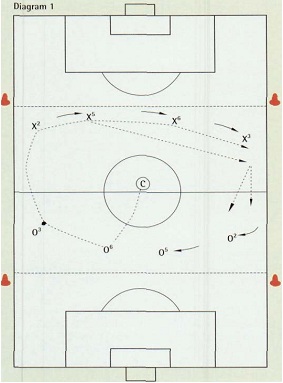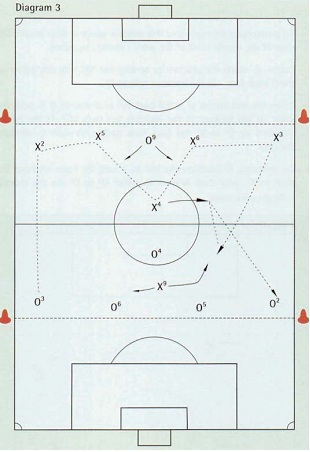Playing in the back four
This document is based on information written by Dick Bate (National Coach U15 in England). It is quite common amongst most teams to play with a back four in defence. Certainly, when I was in charge of the Pakistan International XI team, the players seemed comfortable to play with a back four. Although playing in a back four requires players to interchange positions, the basic concept is widely used. I tend to encourage most teams I coach to play from the back line and find the following practices useful. If there are more than one team in the club, then it may be useful to use two sets of a back four. If not, then you may simply be able to use a back four and a midfield four.
- No goalkeepers are needed in this practice which is sited around the edge of the middle third of the pitch – marked by cones.
- Coach C starts the practice by serving the ball into any player of the 0 back four – in the instance here to O6.
- When the ball arrives at a full back (O3 in this case) it is delivered some 30 yds forward to the opposite full back (X2). As the ball is delivered by O3 to X2 the back four pushes forward to compact the play.
- On receiving, X2 transfers the ball to X5 and the team ‘changes the play’ to X3, who then delivers to either O2 or O5 for the process to begin once more.
Technical content of the practice
• Attacking
• ‘Changing the play’
• Shape of the back line, distances from each other.
• Quickly with minimum touches, possibly ‘missing out’ a centre back in the process.
• Awareness of others positioning prior to receiving the ball.
• Pass quality – along the back line
– forward to the other group.
• Supporting the forward pass
– pushing forward
– when?
– how far?
• Distances between players and role as the ball is moved across the field.
• Defending
• ‘Sliding’ defence across the pitch as opposite back four transfers the ball across their line.
• Positioning off other players in the back four – ahead, behind, distances.
• Depth of the back-line and awareness of others movements.
• ‘Spreading’ quickly as a back four player receives the incoming pass
– where, how, speed etc ?
• Introduce one central midfield player (or two if the team operates with two central midfield players} to each team.
The central midfield player X4/04 can now combine his play with the back four players. The four centre backs (X5, X6, O5, O6) can now receive pass and run with the ball into the midfield area, as in diagram 2. Should this action take place, then X4 replaces X6 (in the Diagram) and becomes an integral part of the back line and X6 now operates as a
midfield player. Also, on receiving the ball at the back, X6 may choose to play a “cross-pass” with X4 as he comes out of the back line. Once into the midfield area, our central back now distributes the ball into the opposite back-line and the whole process can be repeated. Additionally, the back four may choose to involve the central midfield player in
changing the play across the back, as illustrated by the Os back line in Diagram 2.
Technical content of the practice
• Attacking
• ‘Changing the play’ – all factors from Practice 1
• Combining with central midfield players
– wall passes
– feints to pass to central midfield
• Running with the ball from base line and adjustments of position from other defenders
• Involving the central midfield player in changing the play.
• Pass quickly
– across the back line
– to and from the central midfield player
– distribution from the central back in midfield areas
• Central midfield operating in the back line
• Central back operating in midfield
• Spreading and supporting any pass receiver
– where?
– when?
– how?
• Central midfield positioning distances as back four arranges the play.
• Defending
• ‘Sliding’ defence as the ball is changed across the opposition back line.
• Positioning off other players in the back four.
• Depth of the back-line and awareness of others movements.
• ‘Sliding’ of central midfield player as opponents change the play, etc.
Two more players are introduced with the practice. X9 and 09 operate to disrupt the flow of the play across the back line and also to act as targets for forward passes from the back players in possession. The central midfield player still operates ahead of the back line but now chooses his positions according to the movements of the striker opposing the back line players. Striker X9 in practice 3 moves according to the flow of play and where appropriate, is a receiver of the ball from his own back line.
However, back players may still pass to their opponents back line if X9 cannot make a logical and suitable position to receive. Should the striker X9 or O9 receive a pass from a back player he could lay the ball off to the central midfield player moving to support him, or feed any other
member of the back line moving forward to support. The receiver from X9 (in practice 3) now plays the ball into the back four of the ‘0’ team and they initiate play at the back once again.
Technical content of the practice
• Attacking
• As in Practice 1 and Practice 2.
• Back four players supporting striker receiving the ball.
• Quality of passes with striker’s feet for ease of lay off.
• Positioning and movement of central midfield player supporting the receiving striker.
• Defending
• As in Practice 1 and Practice 2.
• Who marks X9/09 (striker) receiving forward passes?
• How is the striker marked?
• Is the back four defence to be organised as a zonal back four or man-for-man marker on the striker and a free back?
Further players can be introduced and the field lengthened. Play is from penalty area to penalty area and goals and goalkeepers now introduced, and a final progression could be made to play 11 v 11 on a full size pitch. Two wingers and two more midfield players are added to the practice,
which commences when either coach or an opposition player (in Diagram 4 it is O7) plays the ball to the goalkeeper. The back four positions to play out from the back and attempts to do so introducing midfield players if necessary. Play is free with the intention to score past the opponent’s goalkeeper.
Technical content of the practice
• Attacking
• Back four ‘shape’ to receive from the goalkeeper against three opponents.
• Awareness, controlling, touch and decision to pass, run the ball or combine with other players to progress the play from the back.
• Support and positioning of midfield players to assist any back player coming out from the back with the ball.
• Positioning of forward players in central and wide positions to receive passes from back players.
• Interchange of positions between back and midfield players.
• Distribution over short and longer ranges from back players.
• Operating as a midfield player on coming forward from the back etc.
• Roles of midfield players on forwards receiving passes from the back.
• Defending
• Roles and responsibilities of a zonal back four, or man-for-man and free back roles.
• Showing ‘infield’ or ‘outside’ by full backs.
• Marking, challenging, blocking and defending against crosses.
• Back four distance from the ball when play is with opposition back four.
• Back four and goalkeeper understanding.
In the practices above, the coach may wish to work with both sets of back fours offensively and defensively. However, it may always be recommended to simply work with one team.





